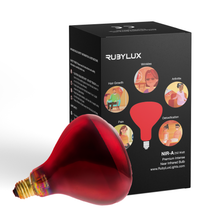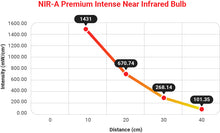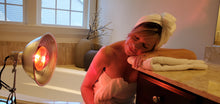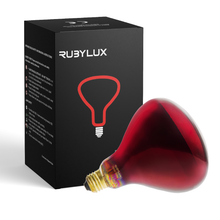
For instructions and safety information, click here.
Available in 120V (for USA and Canada) and 220V (for EU, Australia and many other countries) versions. The 120V bulbs cannot be used in countries with 220V power systems unless a converter is used. Please choose the correct voltage for your country.
FAQ on RubyLux NIR-A Individual Infrared Bulbs - Grade A
What's the Difference between this Grade A Bulb and the Grade B Version?
The difference between the Grade A and the Grade B bulbs is cosmetic. The Grade B bulbs have minor cosmetic defects. Grade A bulbs do not.
The Grade B have minor irregularities (usually imperfections in the red tint that is baked into the glass of the bulb).
The performance, specs, CE approved status, safety, source and everything else about the two types is identical aside from those irregularities in the bulb’s cosmetic glass coloring. We tint the glass because most people have said they like the glowing red light and find it pleasant. However, the visible color of the bulbs is not usually the reason our customers purchase the bulbs. They are usually concerned about the heat and near infrared light output.
We do not feel comfortable selling these bulbs for full price like some of our competitors do with their cosmetic defect bulbs. Although the difference is minor and doesn’t affect performance, we think customers have a right to know exactly what they are buying. So we differentiate between the two bulb types in case a customer does mind if the bulbs have any cosmetic paint defects or in case they are giving a bulb as a gift and want it to look nice.
The eye protection requirements are exactly the same for both types of bulbs.
For what it's worth, the Grade B bulbs are the ones the owner uses every day for herself.
How Many mW/cm2 Does This Bulb Emit?
At 4 inches (10 cm), this bulb emits 1,431 mW/cm2. At 8 inches (20 cm), it emits 671 mW/cm2.
What's the Difference between this Bulb and the RubyLux LED Bulbs?
The answer depends on which color of RubyLux LED Bulb you are comparing this bulb to.
Compared to any of our LED bulbs, the one big difference is heat. The NIR-A Near Infrared Bulb emits a great deal of heat. So much so that people use multiple NIR-A bulbs together to heat their own saunas. None of our LED type bulbs get this hot.
If you want the power of light without the heat, choose our All Red LED Bulb or one of our 2nd Generation Red & Near Infrared LED Bulbs instead.
Compared to the RubyLux All Yellow Amber LED Bulb: The yellow one is popular as a lower power and gentler alternative to red and infrared light. People with very sensitive skin (like those with rosacea) sometimes prefer it because they believe it works better for them. The research on yellow light is scarce and so it is hard for us to say whether it works or not, but customers have asked for it so we sell it. Overall, their feedback about it has been positive.
Compared to any of our LED type bulbs that have blue light, one big difference is that blue light is used for killing bacteria.
Which is Better: Red or Near Infrared Light?
As far as effectiveness, red and near infrared are very similar. Some studies have shown them to be equal, while others have shown near infrared to have a very slight advantage in effectiveness.
One disadvantage of near infrared light is that excessive exposure to infrared light can contribute to the formation of cataracts. This is one reason wearing appropriate eye protection is so important.
How Do I Use My RubyLux NIR-A Near Infrared Bulb?











